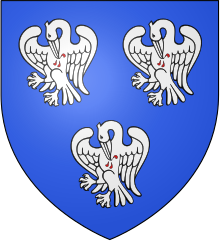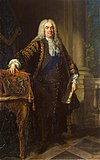Henry Pelham
Prime Minister of Great Britain | |
|---|---|
| In office 27 August 1743 – 6 March 1754 | |
| Monarch | George II |
| Preceded by | The Earl of Wilmington |
| Succeeded by | The Duke of Newcastle |
| Chancellor of the Exchequer | |
| In office 12 December 1743 – 6 March 1754 | |
| Monarch | George II |
| Preceded by | Samuel Sandys |
| Succeeded by | William Lee |
| Personal details | |
| Born | 25 September 1694 Laughton, Sussex, England |
| Died | 6 March 1754 (aged 59) Westminster, England |
| Resting place | All Saints' Church, Laughton, East Sussex, England |
| Political party | Whig |
| Spouse | |
| Children | 4 |
| Parent |
|
| Alma mater | |
| Signature |  |
Henry Pelham
Pelham's premiership was relatively uneventful in terms of domestic affairs, although it was during his premiership that
Early life
Pelham, Newcastle's younger brother, was a younger son of
As a volunteer he served in Dormer's regiment at the
Career

Government
Through strong family influence, and the recommendation of
In 1742 a union of parties resulted in the formation of an administration in which Pelham became Prime Minister the following year, succeeding the Earl of Wilmington after his death.
Prime Minister
Appointment

The first year of Pelham's premiership is regarded as a continuation of the
In November 1744, the Pelhams forced Lord Carteret out of the ministry: Pelham bluntly told the king that either Carteret step down, or the Pelhamites would, leaving His Majesty without a government. Thereafter Pelham shared power with his brother, the Duke of Newcastle upon Tyne. Pelham was regarded as the leading figure, but rank and influence made his brother very powerful in the Cabinet. In spite of a genuine attachment, there were occasional disputes between them, which sometimes led to further difficulties.
"The Broad-Bottomed Administration"
Being strongly in favour of peace, Pelham carried on the War of the Austrian Succession with languor and indifferent success, but the country, wearied of the interminable struggle, was disposed to acquiesce in his foreign policy almost without a murmur. King George II, thwarted in his own favourite schemes, made overtures in February 1746 to Lord Bath, but his purpose was upset by the resignation of the two Pelhams (Henry and Newcastle), who, after a two-day hiatus in which Bath and Carteret (now earl Granville) proved unable to form a ministry, resumed office at the king's request. One of their terms was to insist that the king should have 'total confidence' in a ministry; rather than partial grudging acceptance of the Whigs.

The Augustan era was essential to the development of prime ministerial power as being entirely dependent on a Commons majority, rather than royal prerogative interventions. While the king struggled with his headstrong son, Frederick, Prince of Wales, his son's uncertain constitutional position was high in the Leicester House party set. In 1748 Frederick, a Tory, planned to bring down the Pelhamites at a general election due the following year. The Prime Minister called an early poll in 1748 by asking the king to dissolve parliament in 1747. The prince and his father, the king grew to hate one another with unspeakable animosity. But one consequence was a closer relationship between Henry Pelham and the Sovereign. When he finally died in 1754, the King remarked "Now I shall have no more peace." The Treaty of Aix-la-Chapelle had been signed in 1748 leading inexorably to a number of cost-cutting budgetary measures.
Economic reform
The Army and Navy spending shrunk from £12 m to £7 million per annum. Pelham promised to reduce interest rates through introduction of a balancing act measure from 4% to 3% by 1757. He also assisted a fund to reduce the National Debt. In 1749, the
One social consequence of the press gangs going to sea in an expansive navy fleet was the growth of industrial processes necessary for warfare. The distillation of gin reduced the price of alcohol, resulting in
Death
Two of Pelham's final acts were the
Achievements
His very defects were among the chief elements of Pelham's success, for one with a strong personality, moderate amount self-respect, or haughty conceptions of statesmanship could not have restrained the discordant elements of the cabinet for any length of time the way he did. Moreover, he possessed tact and a thorough acquaintance with the forms of the
subdued manner concealed a shrewd and calculating politician. He was reserved and cautious, but behind the reserve was steel. All agreed on his integrity, which was remarkable in a venal age; unlike Walpole, he died relatively poor.[8]
Personal life

Pelham married Lady Catherine Manners, daughter of the 2nd Duke of Rutland, on 31 October 1726 in the Parish of St James, City of Westminster.[10] They had four daughters:
- Catherine Pelham-Clinton, Countess of Clinton (1727–1760), married 1744 Henry Clinton, 9th Earl of Lincoln, who by this marriage subsequently became the 2nd Duke of Newcastle (Newcastle-under-Lyme)
- Frances (1728–1775), died unmarried
- Grace Watson, Baroness Sondes (1735–1777), married 1752 the Hon. Lewis Watson, who in 1760 was created Baron Sondes
- Mary (1739–1???), died unmarried
When Pelham was elevated to Prime Minister, he began construction of a house located at 22 Arlington Street in St James's, Westminster. He hired the architect William Kent to build the structure in two phases.[11] Kent died in 1748[12] and the work was completed by Stephen Wright[13] in 1754.[11]
Pelham died in 1754 and was buried in All Saints' Church,
Ancestry
| Ancestors of Henry Pelham | ||||||||||||||||||||||||||||||||||||||||||||||||||||||||||||||||||||||||||||||||||||||||||||||||||||||||||||||||||||||||||||||||||||||||||||||||||||||||||||||||||||||||||||||||||||||||||||||||||||||||||||||||||
|---|---|---|---|---|---|---|---|---|---|---|---|---|---|---|---|---|---|---|---|---|---|---|---|---|---|---|---|---|---|---|---|---|---|---|---|---|---|---|---|---|---|---|---|---|---|---|---|---|---|---|---|---|---|---|---|---|---|---|---|---|---|---|---|---|---|---|---|---|---|---|---|---|---|---|---|---|---|---|---|---|---|---|---|---|---|---|---|---|---|---|---|---|---|---|---|---|---|---|---|---|---|---|---|---|---|---|---|---|---|---|---|---|---|---|---|---|---|---|---|---|---|---|---|---|---|---|---|---|---|---|---|---|---|---|---|---|---|---|---|---|---|---|---|---|---|---|---|---|---|---|---|---|---|---|---|---|---|---|---|---|---|---|---|---|---|---|---|---|---|---|---|---|---|---|---|---|---|---|---|---|---|---|---|---|---|---|---|---|---|---|---|---|---|---|---|---|---|---|---|---|---|---|---|---|---|---|---|---|---|---|
| ||||||||||||||||||||||||||||||||||||||||||||||||||||||||||||||||||||||||||||||||||||||||||||||||||||||||||||||||||||||||||||||||||||||||||||||||||||||||||||||||||||||||||||||||||||||||||||||||||||||||||||||||||
In popular culture
Pelham was played by Roger Allam in the 2011 film Pirates of the Caribbean: On Stranger Tides.[citation needed]
Arms
Notes
- ^ "Pelham, Henry (PLHN709H)". A Cambridge Alumni Database. University of Cambridge.
- ^ Foster, Joseph. "'Peach-Peyton', in Alumni Oxonienses 1500-1714, ed. Joseph Foster (Oxford, 1891), pp. 1131-1154". British History Online. Retrieved 10 September 2018.
- ^ Courtney, William Prideaux (1894). . In Lee, Sidney (ed.). Dictionary of National Biography. Vol. 40. London: Smith, Elder & Co.
- ^ a b "PELHAM, Hon. Henry (1695-1754), of Esher Place, Surr". History of Parliament Online. Retrieved 10 September 2018.
- ^ Gilbert W. Daynes (1 December 2019). "Freemasonry and Social England in the Eighteenth Century". The Skirret. Retrieved 1 December 2019.
- ^ Brumwell, p.159
- ^ Williams, Basil (1962). Whig Supremacy: 1714–1760. pp. 259–270.
- ^ a b Brumwell, Stephen; Speck, W. A. (2002). Cassell's Companion to Eighteenth Century Britain. p. 288.
- ^ Marshall, Dorothy (1974). Eighteenth Century England. pp. 221–227.
- ^ The Register of Marriages in the Parish of St James within the Liberty of Westminster. 1723-1754. 31 October 1726.
- ^ a b "About this project". Architecture. London, England: The Royal Institute of British Architects. Retrieved 30 June 2015.
- ^ "William Kent". Oxford Dictionary of National Biography. England: Oxford University Press. Retrieved 30 June 2015.
- ^ Historic England. "Location Wimbourne House, 22, Arlington Street SW1 (1066498)". National Heritage List for England. Retrieved 30 June 2015.
- ^ PelODNB.
References
- Ballantyne, Archibald. Lord Carteret: A Political Biography 1690 to 1763 (1887) online
- Coxe, William, Memoirs of the administration of the Right Honourable Henry Pelham, collected from the family papers, and other authentic documents (2 vol. 1829) online
- Leonard, Dick. "Henry Pelham—Pragmatic Heir to Walpole." in Dick Leonard, ed. Eighteenth-Century British Premiers (Palgrave Macmillan UK, 2011) pp. 40–53.
- Marshall, Dorothy. Eighteenth Century England (2nd ed. 1974) political history 1714–1784,
- Wilkes, John (1964). A Whig in Power: The Political Career of Henry Pelham. London.
{{cite book}}: CS1 maint: location missing publisher (link) - Williams, Basil. The Whig Supremacy: 1714-1760 (2nd ed. 1962).
- Some material has been adapted from the 1911 Encyclopædia Britannica.
- Kulisheck, A. J. "Pelham, Henry". doi:10.1093/ref:odnb/21789. (Subscription or UK public library membershiprequired.); cited as PelODNB.
- "Henry Pelham". Encyclopedia Britannica. The Editors of Encyclopedia Britannica. 28 July 1999. Retrieved 23 November 2022.
External links
- More about Henry Pelham on the Downing Street website.
- Biography of Henry Pelham, with links to online catalogues, on the website of Manuscripts and Special Collections, The University of Nottingham
 "Pelham, Henry (1695?-1754)". Dictionary of National Biography. London: Smith, Elder & Co. 1885–1900.
"Pelham, Henry (1695?-1754)". Dictionary of National Biography. London: Smith, Elder & Co. 1885–1900.



